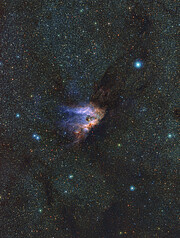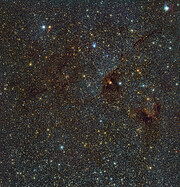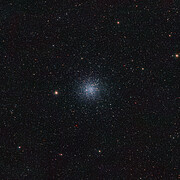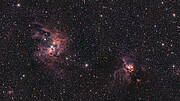Communiqué de presse
Le télescope de l'ESO dresse la carte infrarouge la plus détaillée jamais réalisée de la Voie lactée
26 septembre 2024
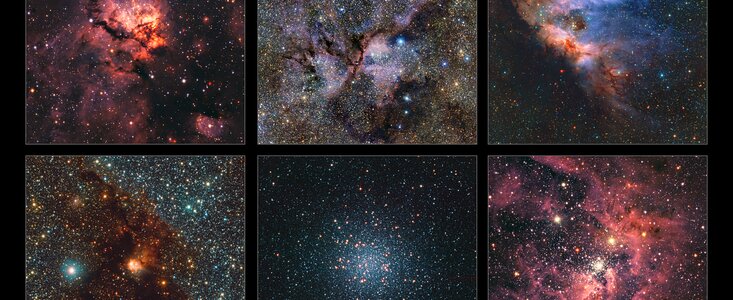
Des astronomes ont publié une gigantesque carte infrarouge de la Voie lactée contenant plus de 1,5 milliard d'objets. Il s'agit de la carte la plus détaillée jamais réalisée à ce jour. À l'aide du télescope VISTA de l'Observatoire Européen Austral, l'équipe a observé les régions centrales de notre galaxie pendant plus de 13 ans. Avec 500 téraoctets de données, ce projet d'observation est le plus important jamais réalisé avec un télescope de l'ESO.
« Nous avons fait tellement de découvertes que nous avons changé la vision de notre galaxie pour toujours », déclare Dante Minniti, astrophysicien à l'université Andrés Bello au Chili, qui a dirigé l'ensemble du projet.
Cette carte record comprend 200 000 images prises par le télescope VISTA (Visible and Infrared Survey Telescope for Astronomy) de l'ESO. Situé à l'observatoire de Paranal de l'ESO au Chili, ce télescope a pour mission principale de cartographier de vastes zones du ciel. L'équipe a utilisé la caméra infrarouge VIRCAM de VISTA, qui peut scruter la poussière et le gaz qui imprègnent notre galaxie. Elle est donc capable de voir le rayonnement des endroits les plus cachés de la Voie lactée, ouvrant ainsi une fenêtre unique sur notre environnement galactique.
Ce gigantesque ensemble de données [1] couvre une zone du ciel équivalente à 8600 pleines lunes, et contient environ 10 fois plus d'objets qu'une précédente carte publiée par la même équipe en 2012. Il comprend des étoiles naissantes, qui sont souvent enfouies dans des cocons poussiéreux, et des amas globulaires - des groupes denses de millions d'étoiles parmi les plus anciennes de la Voie lactée. En observant la lumière infrarouge, VISTA peut également repérer des objets très froids, qui brillent à ces longueurs d'onde, comme les naines brunes (des étoiles « ratées » qui n'ont pas de fusion nucléaire soutenue) ou les planètes errantes qui ne sont pas en orbite autour d'une étoile.
Les observations ont commencé en 2010 et se sont terminées au cours du premier semestre 2023, soit 420 nuits au total. En observant chaque parcelle du ciel plusieurs fois, l'équipe a pu non seulement déterminer l'emplacement de ces objets, mais aussi suivre leurs mouvements et leurs changements de luminosité. Ils ont répertorié les étoiles dont la luminosité change périodiquement et qui peuvent être utilisées comme des règles cosmiques pour mesurer les distances [2]. Cela nous a permis d'obtenir une vue 3D précise des régions intérieures de la Voie lactée, qui étaient auparavant cachées par la poussière. Les chercheurs ont également suivi les étoiles hypervéloces - des étoiles rapides catapultées depuis la région centrale de la Voie lactée après une rencontre rapprochée avec le trou noir supermassif qui s'y trouve.
La nouvelle carte contient des données recueillies dans le cadre de l'étude VISTA Variables in the Vía Láctea (VVV) [3] et de son projet complémentaire, l'étude VVV eXtended (VVVX). « Ce projet a représenté un effort monumental, rendu possible parce que nous étions entourés d'une équipe formidable », déclare Roberto Saito, astrophysicien à l'Universidade Federal de Santa Catarina au Brésil et auteur principal de l'article publié aujourd'hui dans Astronomy & Astrophysics sur l'achèvement du projet.
Les enquêtes VVV et VVVX ont déjà donné lieu à plus de 300 articles scientifiques. Les études étant maintenant terminées, l'exploration scientifique des données recueillies se poursuivra pendant les décennies à venir. Pendant ce temps, l'Observatoire de Paranal de l'ESO se prépare pour l'avenir : VISTA sera mis à niveau avec son nouvel instrument 4MOST et le Very Large Telescope (VLT) de l'ESO recevra son instrument MOONS. Ensemble, ils fourniront les spectres de millions d'objets étudiés ici, et d'innombrables découvertes sont attendues.
Notes
[1] L'ensemble des données est trop volumineux pour être publié sous forme d'image unique, mais les données traitées et le catalogue des objets sont accessibles sur le portail scientifique de l'ESO.
[2] Une façon de mesurer la distance d'une étoile est de comparer sa luminosité vue de la Terre à sa luminosité intrinsèque, mais cette dernière est souvent inconnue. Certains types d'étoiles changent périodiquement de luminosité, et il existe un lien très étroit entre la rapidité avec laquelle elles changent de luminosité et leur luminosité intrinsèque. La mesure de ces fluctuations permet aux astronomes de déterminer la luminosité de ces étoiles, et donc leur distance.
[3] Vía Láctea est le nom latin de la Voie lactée.
Plus d'informations
Cette recherche a été présentée dans un article intitulé « The VISTA Variables in the Vía Láctea eXtended (VVVX) ESO public survey : Completion of the observations and legacy » publié dans Astronomy & Astrophysics (https://doi.org/10.1051/0004-6361/202450584). Données DOI : VVV, VVVX.
L'équipe est composée de R. K. Saito (Departamento de Física, Universidade Federal de Santa Catarina, Florianópolis, Brazil [UFSC]), M. Hempel (Instituto de Astrofísica, Dep. de Ciencias Físicas, Facultad de Ciencias Exactas, Universidad Andres Bello, Providencia, Chile [ASTROUNAB] and Max Planck Institute for Astronomy, Heidelberg, Germany), J. Alonso-García (Centro de Astronomía, Universidad de Antofagasta, Antofagasta, Chile [CITEVA] and Millennium Institute of Astrophysics, Providencia, Chile [MAS]), P. W. Lucas (Centre for Astrophysics Research, University of Hertfordshire, Hatfield, United Kingdom [CAR]), D. Minniti (ASTROUNAB; Vatican Observatory, Vatican City, Vatican City State [VO] and UFSC), S. Alonso (Departamento de Geofísica y Astronomía, CONICET, Facultad de Ciencias Exactas, Físicas y Naturales, Universidad Nacional de San Juan, Rivadavia, Argentina [UNSJ-CONICET]), L. Baravalle (Instituto de Astronomía Teórica y Experimental, Córdoba, Argentina [IATE-CONICET]; Observatorio Astronómico de Córdoba, Universidad Nacional de Córdoba, Argentina [OAC]), J. Borissova (Instituto de Física y Astronomía, Universidad de Valparaíso, Valparaíso, Chile [IFA-UV] and MAS), C. Caceres (ASTROUNAB), A. N. Chené (Gemini Observatory, Northern Operations Center, Hilo, USA), N. J. G. Cross (Wide-Field Astronomy Unit, Institute for Astronomy, University of Edinburgh, Royal Observatory, Edinburgh, United Kingdom), F. Duplancic (UNSJ-CONICET), E. R. Garro (European Southern Observatory, Vitacura, Chile [ESO Chile]), M. Gómez (ASTROUNAB), V. D. Ivanov (European Southern Observatory, Garching bei München [ESO Germany]), R. Kurtev (IFA-UV and MAS), A. Luna (INAF – Osservatorio Astronomico di Capodimonte, Napoli, Italy [INAF- OACN]), D. Majaess (Mount Saint Vincent University, Halifax, Canada), M. G. Navarro (INAF – Osservatorio Astronomico di Roma, Italy [INAF-OAR]), J. B. Pullen (ASTROUNAB), M. Rejkuba (ESO Germany), J. L. Sanders (Department of Physics and Astronomy, University College London, London, United Kingdom), L. C. Smith (Institute of Astronomy, University of Cambridge, Cambridge, United Kingdom), P. H. C. Albino (UFSC), M. V. Alonso (IATE-CONICET and OAC), E. B. Amôres (Departamento de Física, Universidade Estadual de Feira de Santana, Feira de Santana, Brazil), E. B. R. Angeloni (Gemini Observatory/NSF’s NOIRLab, La Serena, Chile [NOIRLab]), J. I. Arias (Departamento de Astronomía, Universidad de La Serena, La Serena, Chile [ULS]), M. Arnaboldi (ESO Germany), B. Barbuy (Universidade de São Paulo, São Paulo, Brazil), A. Bayo (ESO Germany), J. C. Beamin (ASTROUNAB and Fundación Chilena de Astronomía, Santiago, Chile), L. R. Bedin (Istituto Nazionale di Astrofisica, Osservatorio Astronomico di Padova, Padova, Italy [INAF-OAPd]), A. Bellini (Space Telescope Science Institute, Baltimore, USA [STScI]), R. A. Benjamin (Department of Physics, University of Wisconsin-Whitewater, Whitewater, USA), E. Bica (Departamento de Astronomia, Instituto de Física, Porto Alegre, Brazil [IF – UFRGS]), C. J. Bonatto (IF – UFRGS), E. Botan (Instituto de Ciências Naturais, Humanas e Sociais, Universidade Federal de Mato Grosso, Sinop, Brazil), V. F. Braga (INAF-OAR), D. A. Brown (Vatican Observatory, Tucson, USA), J. B. Cabral (IATE-CONICET and Gerencia De Vinculación Tecnológica, Comisión Nacional de Actividades Espaciales, Córdoba, Argentina), D. Camargo (Colégio Militar de Porto Alegre, Ministério da Defesa, Exército Brasileiro, Brazil), A. Caratti o Garatti (INAF- OACN), J. A. Carballo-Bello (Instituto de Alta Investigación, Universidad de Tarapacá, Arica, Chile [IAI-UTA]), M.Catelan (Instituto de Astrofísica, Pontificia Universidad Católica de Chile, Santiago, Chile [Instituto de Astrofísica UC]; MAS and Centro de Astro-Ingeniería, Pontificia Universidad Católica de Chile, Santiago, Chile [AIUC]), C. Chavero (OAC and Consejo Nacional de Investigaciones Científica y Técnicas, Ciudad Autónoma de buenos Aires, Argentina [CONICET]), M. A. Chijani (ASTROUNAB), J. J. Clariá (OAC and CONICET), G. V. Coldwell (UNSJ-CONICET), C. Contreras Peña (Department of Physics and Astronomy, Seoul National University, Seoul, Republic of Korea and Research Institute of Basic Sciences, Seoul National University, Seoul, Republic of Korea), C. R. Contreras Ramos (Instituto de Astrofísica UC and MAS), J. M. Corral-Santana (ESO Chile), C. C. Cortés (Departamento de Tecnologías Industriales, Faculty of Engineering, Universidad de Talca, Curicó, Chile), M. Cortés-Contreras (Departamento de Física de la Tierra y Astrofísica & Instituto de Física de Partículas y del Cosmos de la UCM, Facultad de Ciencias Físicas, Universidad Complutense de Madrid, Madrid, Spain), P. Cruz (Centro de Astrobiología, CSIC-INTA, Madrid, Spain [CAB]), I. V. Daza-Perilla (CONICET; IATE-CONICET and Facultad de Matemática, Astronomía, Física y Computación, Universidad Nacional de Córdoba, Córdoba, Argentina), V. P. Debattista (University of Central Lancashire, Preston, United Kingdom), B. Dias (ASTROUNAB), L. Donoso (Instituto de Ciencias Astronómicas, de la Tierra y del Espacio, San Juan, Argentina), R. D’Souza (VO), J. P. Emerson (Astronomy Unit, School of Physical and Chemical Sciences, Queen Mary University of London, London, United Kingdom), S. Federle (ESO Chile and ASTROUNAB), V. Fermiano (UFSC), J. Fernandez (UNSJ-CONICET), J. G. Fernández-Trincado (Instituto de Astronomía, Universidad Católica del Norte, Antofagasta, Chile [IA-UCN]), T. Ferreira (Department of Astronomy, Yale University, New Haven, USA), C. E. Ferreira Lopes (Instituto de Astronomía y Ciencias Planetarias, Universidad de Atacama, Copiapó, Chile [INCT] and MAS), V. Firpo (NOIRLab), C. Flores-Quintana (ASTROUNAB and MAS), L. Fraga (Laboratorio Nacional de Astrofísica, Itajubá, Brazil), D.Froebrich (Centre for Astrophysics and Planetary Science, School of Physics and Astronomy, University of Kent, Canterbury, United Kingdom), D. Galdeano (UNSJ-CONICET), I. Gavignaud (ASTROUNAB), D. Geisler (Departamento de Astronomía, Universidad de Concepción, Chile [UdeC]; Instituto Multidisciplinario de Investigación y Postgrado, Universidad de La Serena, Chile [IMIP-ULS] and ULS), O. E.Gerhard (Max Planck Institute for Extraterrestrial Physics, Germany [MPE]), W. Gieren (UdeC), O. A. Gonzalez (UK Astronomy Technology Centre, Royal Observatory Edinburgh, Edinburgh, United Kingdom), L. V. Gramajo (OAC and CONICET), F. Gran (Université Côte d’Azur, Observatoire de la Côte d’Azur, CNRS, Laboratoire Lagrange, Nice, France [Lagrange]), P. M. Granitto (Centro Internacional Franco Argentino de Ciencias de la Información y de Sistemas, Rosario, Argentina), M. Griggio (INAF-OAPd; Dipartimento di Fisica, Università di Ferrara, Ferrara, Italy and STScI), Z. Guo (IFA-UV and MAS), S. Gurovich (IATE-CONICET and Western Sydney University, Kingswood, Australia), M. Hilker (ESO Germany), H. R. A. Jones (CAR), R. Kammers (UFSC), M. A. Kuhn (CAR), M. S. N. Kumar (Centro de Astrofísica da Universidade do Porto, Porto, Portugal), R. Kundu (Miranda House, University of Delhi, India and Inter University centre for Astronomy and Astrophysics, Pune, India), M. Lares (IATE-CONICET), M. Libralato (INAF-OAPd), E. Lima (Universidade Federal do Pampa, Uruguaiana, Brazil), T. J. Maccarone (Department of Physics & Astronomy, Texas Tech University, Lubbock, USA), P. Marchant Cortés (ULS), E. L. Martin (Instituto de Astrofisica de Canarias and Departamento de Astrofísica, Universidad de La Laguna, San Cristóbal de la Laguna, Spain), N. Masetti (Istituto Nazionale di Astrofisica, Osservatorio di Astrofisica e Scienza dello Spazio di Bologna, Bologna, Italy and ASTROUNAB), N. Matsunaga (Department of Astronomy, Graduate School of Science, The University of Tokyo, Japan), F. Mauro (IA-UCN), I. McDonald (Jodrell Bank Centre for Astrophysics, The University of Manchester, UK [JBCA]), A. Mejías (Departamento de Astronomía, Universidad de Chile, Las Condes, Chile), V. Mesa (IMIP-ULS; Association of Universities for Research in Astronomy, Chile, Grupo de Astrofísica Extragaláctica-IANIGLA; CONICET, and Universidad Nacional de Cuyo, Mendoza, Argentina), F. P. Milla-Castro (ULS), J. H. Minniti (Department of Physics and Astronomy, Johns Hopkins University, Baltimore, USA), C. Moni Bidin (IA-UCN), K. Montenegro (Clínica Universidad de los Andes, Santiago, Chile), C. Morris (CAR), V. Motta (OAC), F. Navarete (SOAR Telescope/NSF’s NOIRLab, La Serena, Chile), C. Navarro Molina (Centro de Docencia Superior en Ciencias Básicas, Universidad Austral de Chile, Puerto Montt, Chile), F. Nikzat (Instituto de Astrofísica UC and MAS), J. L. NiloCastellón (IMIP-ULS and ULS), C. Obasi (IA-UCN and Centre for Basic Space Science, University of Nigeria, Nsukka, Nigeria), M. Ortigoza-Urdaneta (Departamento de Matemática, Universidad de Atacama, Copiapó, Chile), T. Palma (OAC), C. Parisi (OAC and IATE-CONICET), K. Pena Ramírez (NSF NOIRLab/Vera C. Rubin Observatory, La Serena, Chile), L. Pereyra (IATE-CONICET), N. Perez (UNSJ-CONICET), I. Petralia (ASTROUNAB), A. Pichel (Instituto de Astronomía y Física del Espacio, Ciudad Autónoma de Buenos Aires, Argentina [IAFE-CONICET]), G. Pignata (IAI-UTA), S. Ramírez Alegría (CITEVA), A. F. Rojas (Instituto de Astrofísica UC, Instituto de Estudios Astrofísicos, Facultad de Ingeniería y Ciencias, Universidad Diego Portales, Santiago, Chile and CITEVA), D. Rojas (ASTROUNAB), A. Roman-Lopes (ULS), A. C. Rovero (IAFE-CONICET), S. Saroon (ASTROUNAB), E. O. Schmidt (OAC and IATE-CONICET), A. C. Schröder (MPE), M. Schultheis (Lagrange), M. A. Sgró (OAC), E. Solano (CAB), M. Soto (INCT), B. Stecklum (Thüringer Landessternwarte, Tautenburg, Germany), D. Steeghs (Department of Physics, University of Warwick, UK), M. Tamura (Department of Astronomy, Graduate School of Science, University of Tokyo; Astrobiology Center, Tokyo, Japan, and National Astronomical Observatory of Japan, Tokyo, Japan), P. Tissera (Instituto de Astrofísica UC and AIUC), A. A. R. Valcarce (Departamento de Física, Universidad de Tarapacá, Chile), C. A. Valotto (IATE-CONICET and OAC), S. Vasquez (Museo Interactivo de la Astronomía, La Granja, Chile), C. Villalon (IATE-CONICET and OAC), S. Villanova (UdeC), F. Vivanco Cádiz (ASTROUNAB), R. Zelada Bacigalupo (North Optics, La Serena, Chile), A. Zijlstra (JBCA and School of Mathematical and Physical Sciences, Macquarie University, Sydney, Australia), and M. Zoccali (Instituto de Astrofísica UC and MAS).
L'Observatoire Européen Austral (ESO) permet aux scientifiques du monde entier de découvrir les secrets de l'Univers pour le bénéfice de tous. Nous concevons, construisons et exploitons des observatoires au sol de classe mondiale - que les astronomes utilisent pour s'attaquer à des questions passionnantes et transmettre la fascination de l'astronomie - et nous encourageons la collaboration internationale en astronomie. Créé en 1962 en tant qu'organisation intergouvernementale, l'ESO est aujourd'hui soutenu par 16 États membres (Allemagne, Autriche, Belgique, Danemark, Espagne, France, Finlande, Irlande, Italie, Pays-Bas, Pologne, Portugal, République tchèque, Royaume-Uni, Suède et Suisse), ainsi que par l'État hôte du Chili et l'Australie en tant que partenaire stratégique. Le siège de l'ESO ainsi que son centre d'accueil et son planétarium, l'ESO Supernova, sont situés près de Munich en Allemagne, tandis que le désert chilien d'Atacama, un endroit magnifique offrant des conditions uniques pour observer le ciel, accueille nos télescopes. L'ESO exploite trois sites d'observation : La Silla, Paranal et Chajnantor. À Paranal, l'ESO exploite le Very Large Telescope et son Very Large Telescope Interferometer, ainsi que des télescopes de sondage tel que VISTA. Toujours à Paranal, l'ESO accueillera et exploitera le Cherenkov Telescope Array South, l'observatoire de rayons gamma le plus grand et le plus sensible au monde. Avec ses partenaires internationaux, l'ESO exploite APEX et ALMA à Chajnantor, deux installations qui observent le ciel dans le domaine millimétrique et submillimétrique. Au Cerro Armazones, près de Paranal, nous construisons "le plus grand œil au monde tourné vers le ciel" - l'Extremely Large Telescope de l'ESO. Depuis nos bureaux de Santiago du Chili, nous soutenons nos opérations dans le pays et nous nous engageons auprès des partenaires et de la société chiliens.
Liens
- L'article scientifique
- Photos des télescopes de sondage à Paranal, y compris VISTA
- Journalistes: Inscrivez-vous pour recevoir nos communiqués sous embargo dans votre langue.
- Scientifiques: Vous avez une histoire ? Racontez-la !
Contacts
Roberto K. Saito
Universidade Federal de Santa Catarina
Florianópolis, Brazil
Courriel: roberto.saito@ufsc.br
Dante Minniti
Universidad Andrés Bello
Santiago, Chile
Courriel: vvvdante@gmail.com
Phil Lucas
University of Hertfordshire
Hartfield, United Kingdom
Courriel: p.w.lucas@herts.ac.uk
Juan Carlos Muñoz-Mateos
ESO Media Officer
Garching bei München, Germany
Tél: +49 89 3200 6176
Courriel: press@eso.org
Rodrigo Alvarez (contact presse pour la Belgique)
Réseau de diffusion scientifique de l'ESO
et Planetarium, Royal Observatory of Belgium
Tél: +32-2-474 70 50
Courriel: eson-belgium@eso.org
A propos du communiqué de presse
| Communiqué de presse N°: | eso2413fr-be |
| Nom: | Milky Way |
| Type: | Milky Way |
| Facility: | Visible and Infrared Survey Telescope for Astronomy |
| Instruments: | VIRCAM |
| Science data: | 2024A&A...689A.148S |
Our use of Cookies
We use cookies that are essential for accessing our websites and using our services. We also use cookies to analyse, measure and improve our websites’ performance, to enable content sharing via social media and to display media content hosted on third-party platforms.
ESO Cookies Policy
The European Organisation for Astronomical Research in the Southern Hemisphere (ESO) is the pre-eminent intergovernmental science and technology organisation in astronomy. It carries out an ambitious programme focused on the design, construction and operation of powerful ground-based observing facilities for astronomy.
This Cookies Policy is intended to provide clarity by outlining the cookies used on the ESO public websites, their functions, the options you have for controlling them, and the ways you can contact us for additional details.
What are cookies?
Cookies are small pieces of data stored on your device by websites you visit. They serve various purposes, such as remembering login credentials and preferences and enhance your browsing experience.
Categories of cookies we use
Essential cookies (always active): These cookies are strictly necessary for the proper functioning of our website. Without these cookies, the website cannot operate correctly, and certain services, such as logging in or accessing secure areas, may not be available; because they are essential for the website’s operation, they cannot be disabled.
Functional Cookies: These cookies enhance your browsing experience by enabling additional features and personalization, such as remembering your preferences and settings. While not strictly necessary for the website to function, they improve usability and convenience; these cookies are only placed if you provide your consent.
Analytics cookies: These cookies collect information about how visitors interact with our website, such as which pages are visited most often and how users navigate the site. This data helps us improve website performance, optimize content, and enhance the user experience; these cookies are only placed if you provide your consent. We use the following analytics cookies.
Matomo Cookies:
This website uses Matomo (formerly Piwik), an open source software which enables the statistical analysis of website visits. Matomo uses cookies (text files) which are saved on your computer and which allow us to analyze how you use our website. The website user information generated by the cookies will only be saved on the servers of our IT Department. We use this information to analyze www.eso.org visits and to prepare reports on website activities. These data will not be disclosed to third parties.
On behalf of ESO, Matomo will use this information for the purpose of evaluating your use of the website, compiling reports on website activity and providing other services relating to website activity and internet usage.
Matomo cookies settings:
Additional Third-party cookies on ESO websites: some of our pages display content from external providers, e.g. YouTube.
Such third-party services are outside of ESO control and may, at any time, change their terms of service, use of cookies, etc.
YouTube: Some videos on the ESO website are embedded from ESO’s official YouTube channel. We have enabled YouTube’s privacy-enhanced mode, meaning that no cookies are set unless the user actively clicks on the video to play it. Additionally, in this mode, YouTube does not store any personally identifiable cookie data for embedded video playbacks. For more details, please refer to YouTube’s embedding videos information page.
Cookies can also be classified based on the following elements.
Regarding the domain, there are:
- First-party cookies, set by the website you are currently visiting. They are stored by the same domain that you are browsing and are used to enhance your experience on that site;
- Third-party cookies, set by a domain other than the one you are currently visiting.
As for their duration, cookies can be:
- Browser-session cookies, which are deleted when the user closes the browser;
- Stored cookies, which stay on the user's device for a predetermined period of time.
How to manage cookies
Cookie settings: You can modify your cookie choices for the ESO webpages at any time by clicking on the link Cookie settings at the bottom of any page.
In your browser: If you wish to delete cookies or instruct your browser to delete or block cookies by default, please visit the help pages of your browser:
Please be aware that if you delete or decline cookies, certain functionalities of our website may be not be available and your browsing experience may be affected.
You can set most browsers to prevent any cookies being placed on your device, but you may then have to manually adjust some preferences every time you visit a site/page. And some services and functionalities may not work properly at all (e.g. profile logging-in, shop check out).
Updates to the ESO Cookies Policy
The ESO Cookies Policy may be subject to future updates, which will be made available on this page.
Additional information
For any queries related to cookies, please contact: pdprATesoDOTorg.
As ESO public webpages are managed by our Department of Communication, your questions will be dealt with the support of the said Department.

